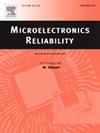A vertical diode-triggered silicon-controlled rectifier with adjustable holding voltage for ESD protection
IF 1.6
4区 工程技术
Q3 ENGINEERING, ELECTRICAL & ELECTRONIC
引用次数: 0
Abstract
This paper presents a vertical diode-triggered silicon-controlled rectifier (VDTSCR) device with adjustable holding voltage, fabricated using 180 nm CMOS technology for 3.3 V and 5 V I/O interface applications. The conventional heavily doped P and N stripes in the SCR well are reconfigured into P and N block regions, which are then connected to separate electrodes to form diodes. These embedded diodes effectively reduce the SCR's trigger voltage. The holding voltage is further improved by cascading multiple identical cells. The ESD characteristics of the proposed VDTSCR and the DTSCR were evaluated using Transmission Line Pulse (TLP) and Very Fast TLP (VFTLP). The proposed VDTSCR structure demonstrates a significant increase in holding voltage, with a 31 % reduction in turn-on time in transient waveforms compared to the DTSCR. Additionally, this paper investigates the quasi-static characteristics of the VDTSCR with various parameter configurations, achieving a figure of merit of 41.6 mA/μm.
求助全文
约1分钟内获得全文
求助全文
来源期刊

Microelectronics Reliability
工程技术-工程:电子与电气
CiteScore
3.30
自引率
12.50%
发文量
342
审稿时长
68 days
期刊介绍:
Microelectronics Reliability, is dedicated to disseminating the latest research results and related information on the reliability of microelectronic devices, circuits and systems, from materials, process and manufacturing, to design, testing and operation. The coverage of the journal includes the following topics: measurement, understanding and analysis; evaluation and prediction; modelling and simulation; methodologies and mitigation. Papers which combine reliability with other important areas of microelectronics engineering, such as design, fabrication, integration, testing, and field operation will also be welcome, and practical papers reporting case studies in the field and specific application domains are particularly encouraged.
Most accepted papers will be published as Research Papers, describing significant advances and completed work. Papers reviewing important developing topics of general interest may be accepted for publication as Review Papers. Urgent communications of a more preliminary nature and short reports on completed practical work of current interest may be considered for publication as Research Notes. All contributions are subject to peer review by leading experts in the field.
 求助内容:
求助内容: 应助结果提醒方式:
应助结果提醒方式:


